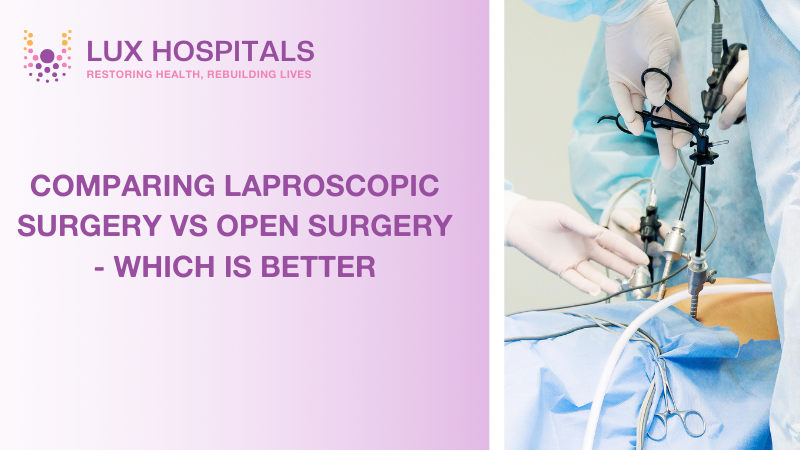Laparoscopic Surgery vs. Open Surgery: Which is Right for You?

When it comes to surgical procedures, patients often face a critical decision: choosing between open surgery vs laparoscopic surgery. Both methods have their unique benefits and potential drawbacks, making it essential to understand which option aligns better with your health needs.
This comprehensive guide will delve into the differences, benefits, and considerations of laparoscopic surgery and open surgery, helping you make an informed decision.
What is Laparoscopic Surgery?
Laparoscopic surgery, also referred to as minimally invasive surgery, is a modern surgical method involving the use of specialized instruments and small incisions. A laparoscope, a thin tube with a camera, is inserted through a small cut, allowing the surgeon to view the internal organs on a screen.
What is Open Surgery?
Open surgery is a traditional procedure that directly accesses the region of concern by making a larger incision. This method provides the surgeon with a full view of the organs and more room to operate, which can be necessary for complex or emergency situations.
Key Differences Between Laparoscopic Surgery vs Open Surgery
Incision Size and Scarring
Laparoscopic Surgery: Involves small incisions (typically less than an inch), resulting in minimal scarring.
Open Surgery: Requires a larger incision, leading to more significant scarring.
Recovery Time
Laparoscopic Surgery: Patients usually experience faster recovery due to smaller incisions and less tissue damage.
Open Surgery: Recovery may take longer because of the larger wound and more extensive tissue manipulation.
Pain and Discomfort
Laparoscopic Surgery: It Reduces postoperative pain and discomfort in most cases.
Open Surgery: Often associated with more pain, requiring longer periods of pain management.
Hospital Stay
Laparoscopic Surgery : often makes it possible to return to routine activities more quickly and stay in the hospital shorter.
Open Surgery: Usually requires a longer hospital stay and extended recovery period.
Advantages of Laparoscopic Surgery
Minimally Invasive: The laparoscopy procedure uses small incisions, reducing the risk of infection and promoting faster healing.
Reduced Pain: Smaller cuts mean less trauma to the body, resulting in reduced pain post-surgery.
Shorter Recovery: Patients can resume normal activities quicker compared to open surgery.
Less Scarring: Small incisions result in less scarring, which is an important aesthetic benefit.
Lower Risk of Complications: The precision of laparoscopic tools often leads to fewer complications.
Disadvantages of Laparoscopic Surgery
Not Suitable for All Conditions: Certain complex conditions may still require open surgery.
Longer Operation Time: The procedure can take longer due to the precision required for small incisions.
Specialised Training Required: Surgeons need specific training and experience to perform laparoscopic surgeries.
Advantages of Open Surgery
Comprehensive Access: The larger incision provides full access to organs, which is crucial for complex surgeries.
Better for Complicated Cases: In situations where extensive surgery is required, open surgery is often the preferred method.
More Versatile: It can be used for a wide range of conditions, especially emergencies.
Disadvantages of Open Surgery
Longer Recovery: The large incision requires more time to heal, delaying the patient’s return to normal activities.
Increased Pain: The larger wound usually results in more pain and discomfort post-operation.
Higher Risk of Infection: Larger wounds are more prone to infections, necessitating more careful postoperative care.
Types of Laparoscopy Procedures
Diagnostic Laparoscopy: Used to diagnose conditions like chronic pelvic pain, unexplained infertility, or abdominal pain.
Therapeutic Laparoscopy: Involves treating a condition, such as removing the gallbladder (cholecystectomy) or repairing a hernia.
Gynecological Laparoscopy: Commonly used for procedures like ovarian cyst removal, endometriosis treatment, or hysterectomy.
Colorectal Laparoscopy: Used for surgeries involving the colon and rectum, like resections or cancer treatments.
Factors to Consider When Choosing Between Laparoscopic and Open Surgery
Nature of the Condition
Some medical conditions may necessitate open surgery, especially if they involve large tumors or complex anatomical challenges. However, many conditions can be effectively treated with laparoscopic surgery, offering a less invasive alternative.
Patient’s Health Status
Patients with certain health conditions or previous surgeries might be better candidates for one approach over the other. Talking to your surgeon about your entire medical history is essential.
Surgeon’s Expertise
The choice of surgery may depend on the surgeon’s expertise and experience with laparoscopy operations. Surgeons who specialise in minimally invasive procedures can provide better outcomes for eligible patients.
Recovery Expectations
If a quick recovery is a priority, laparoscopic surgery might be the better option. However, the nature and complexity of the surgery should also be taken into account.
Conclusion
Choosing between laparoscopic and open surgery is a decision best made with your healthcare provider based on your specific condition. Laparoscopic surgery offers benefits like reduced pain and faster recovery, while open surgery may be necessary for more complex cases. At Lux Hospitals, our expert doctors provide personalised advice and care to ensure you receive the most suitable and effective treatment for your needs.
Frequently Asked Questions
Choose Lux Hospital for open surgery or laparoscopy due to its modern infrastructure and a team of expert doctors with extensive experience, ensuring the highest quality care and successful outcomes.
Laparoscopy is generally better for quicker recovery and less pain, while open surgery is preferred for complex cases. The best option depends on your specific condition.
Surgeons perform laparoscopic surgery instead of open surgery because it involves smaller incisions, less pain, faster recovery, and a lower risk of complications.
Typically, 2-3 days of rest are recommended after a laparoscopy, with most people resuming normal activities within a week.
Long-term side effects of laparoscopic surgery are rare but may include adhesions, chronic pain, or hernia formation. Most patients recover without significant issues.




















